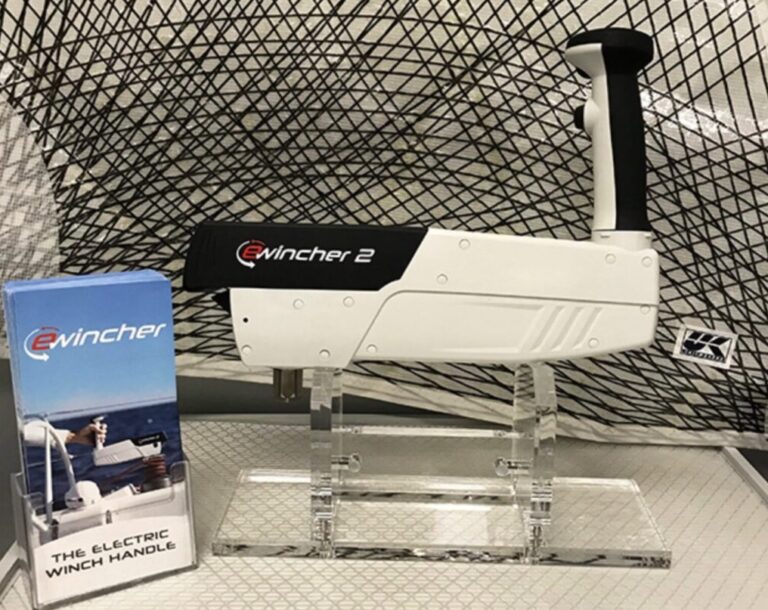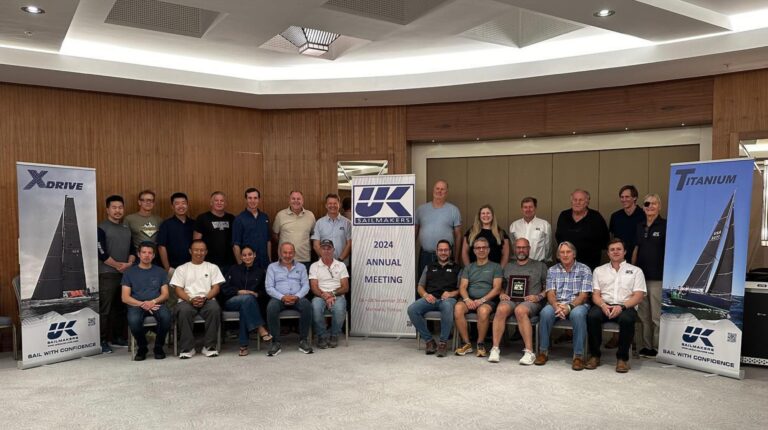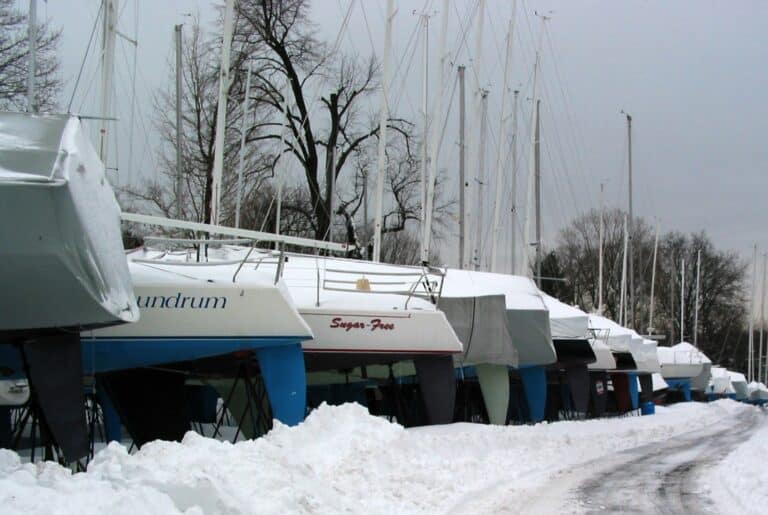Barry Hayes of UK Sailmakers Hong Kong
For decades, most top racing boats had great big overlapping headsails, which develop a lot of power as the overlap of the main by the genoa slows the airflow between the two sails. But the big sails clutter the deck with big winches, long genoa tracks and genoa sheets. More recently, modern boats are being designed with cleaner decks and non-overlapping headsails. A simpler deck and smaller jibs come at the price of much less power — especially in light air.
One solution to this power shortage is the jib inhauler, which really started coming into widespread use with high-performance keelboats such as the Mumm 30 and Farr 40. The inhauler is a purchase system that pulls the jib clew inboard and thereby reduces, or narrows, the sail’s sheeting angle.

To better understand how inhaulers affect your sail trim, let’s first review some basic principles. When sailing upwind in normal trim, the jib slows the airflow as it passes the mainsail’s leading edge (luff), which creates the pressure difference (low on the leeward side of the mainsail, high on the weather side) that makes your sails work. As the jib is trimmed closer to the boat’s centerline, the airflow slows even further, deepening the pressure on the leeward side of the main, which is trimmed accordingly, of course, to prevent it from stalling. The result is improved pointing in light air.
Boats with non-overlapping headsails normally have jib tracks that are angled anywhere from 8 to 10 degrees off the centerline of the boat. This angle creates a wide gap, commonly called the “slot,” between the two sails. With a wide slot, the jib is too far away from the mainsail to sufficiently slow the airflow. The inhaluler moves the leech of the genoa closer to the luff of the mainsail reducing the slot (see photo 1 – The inhauler pulls the clew of the jib in over the cabin house as if it was being trimmed to an inboard track).
For maximum efficiency the jib leech must be parallel to the luff of the main. When the air flows off the genoa at an angle of 10 degrees to the centerline, it’s thrusting the boat forward at a wide angle, but not as efficiently as at 8 degrees, or better yet, 7 degrees. Certain boats, such the Farr 40 and the Mumm 30, are designed to sail with the jib set at 7 degrees. To make this happen, the jib clew must be pulled inboard so the top of the jib is twisting open and the bottom is pulled in parallel with the main.
For an inhauler system to work, the jib clew must be at cabin height. If there’s a lot of leech return (when the exit of the sail turns in towards the centerline), inhauling will create excess drag and slow the boat. Remember that the greater the return on the leech, the more it works like an airplane’s flaps during landing—drag causes the airflow to really slow down, and in turn, backwind the main.
It’s helpful to have a small amount of return in light air; the jib will develop just enough power to provide feel to the helm without losing pointing ability. When the boat is up to speed, it’s not necessary to have return; at this point return just creates speed-sapping drag. With a smaller and flatter jib, say a No. 2 or No. 3, inhauling is not necessary because there’s no need to narrow the slot in stronger winds.
Installation and customization
If your boat doesn’t have inhaulers, and it’s something you’d like to experiment with, there are a number of factors to consider: your current sheeting angle, your keel and hull design, your sail plan, and whether you’ll be able to install an inhauler system that works within the constraints of your deck layout.
With regard to sheeting angles, you’ll encounter performance problems if you start sheeting the jib tighter than the boat is designed for. In other words, if you’re pointing at a higher angle and you slow down, the flow over the keel is reduced which may increase the leeway of the boat. If your standard sheeting angle is at 8 to 10 degrees (off your boat’s centerline), then you shouldn’t have problems inhauling an extra degree or two.
When it comes to keel types, a narrow, slender keel with a short chord length can work well with inhaulers. If the keel’s leading edge is fat, the boat will be slow and sluggish, and it will be harder to get up to speed when you are inhaluled.
Inhauling will not be an option if the clew of your jib is lower than the cabin house roof. If it’s high enough, you’ll be able to set up the inhauler at the correct angle. If the clew is lower than the cabin house, then you’ll need to have your sail re-cut to allow you to inhaul.
If you set up an inhauler, it’s critical that it pulls inboard at an angle perpendicular to the sheet. If it is not, it will increase sheet load or leech return. Other issues that need to be addressed are how the system can be worked into the deck layout; it will need strength in some areas, as the loads can be significant. Most inhaulers are set up on the centerline of the boat using a pad eye. As you can see on the picture of Devocean’s (Swan 45) deck layout, the rope is in a 2:1 system that passes through the block and then forward to the pad eye on deck (see Photo 2 In this set up, the inhauler has a 2:1 purchase only because it led back to a cabin top winch. The sheet passes through a small ring instead of a block because the size and weight of a block dinged up the deck as the sheet flogged in the tacks). The pad eye is supported with a backing plate under the deck; this will enable the pad eye to bear the loads being exerted by the inhauler. Having the system come to a central point makes it easier to trim the inhauler evenly on both sides, which is important because you want equal, repeatable settings from tack to tack. Most racing boats lead the inhauler control line through a block on the cabin top and run it aft to a winch or purchase system on the top of the cabin. One of the most basic set ups is a simple 2:1 purchase leading to a 6:1 pulley system from the pad eye, for say a standard 40 footer.
The smaller boats can get away with using a 4:1 purchase that will have a line coming from the clew of the sail leading to the purchase system. On smaller boats, I’ve always used Spectra rope for inhauler systems. On boats larger than 40 feet, Vectron should be used because it will stretch less than Spectra. When building my systems, I’ve always used Harken blocks, but now there are other companies who have built complete systems, one of the best are from Diverse Yacht Services (www.diverseyachts.com).
Putting them to use
One thing I’ve always found when using inhaulers is that the crew and driver need to work more closely as a team; the ability to adjust the inhauler while the driver keeps the boat in a groove is an art. The driver must learn the fine art of pointing high while keeping the boat up to its polars. Certain boats with inhaulers, such as the Swan 45, are difficult to keep in the groove, and constant work by the crew trimming the jib in conjunction with the driver footing and pointing, working the boat through the speed builds and lulls helps the boat stay in the groove.

When trimming using an inhauler, there are certain rules of thumb. When the boat is starved for power, ease the inhauler a little to let the driver foot a little more until he’s up to speed. This means opening up the slot until the boat is back up to speed. If the driver keeps dropping speed, and can’t settle into a groove, move the car forward to round out the foot a little to make him sail lower. This builds power and helps the driver generate speed faster. You will need to ease the jib sheet when you do this to make the leech parallel to the main.
If the boat is not pointing, the foot may be too round, so flatten it a little by taking in on the sheet or easing the car aft. If the boat is going fast, but not pointing, take on a little more inhauler—up to the coach roof. This will be the limit on how much you can adjust the inhauler. Most of the time, if the boat is not in the groove, it has to do with the driver struggling to keep the boat sailing fast. If this is the case, and he is starved for power, the solution is to ease the inhauler. Most of the time it takes constant work by the crew and the driver to the keep the boat moving in the groove. Inhauling is a very efficient way to develop power from non-overlapping head sails.




